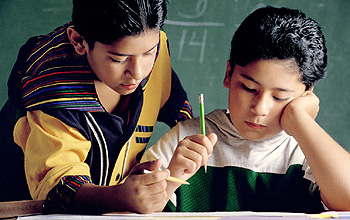News Release 07-121
"Earth & Sky" Launches Spanish-language Radio Series
During National Hispanic Heritage Month, "Cielo y Tierra" expands the audience for science stories

Hispanic students can tune in to science stories on radio and Web through "Cielo y Tierra."
September 18, 2007
This material is available primarily for archival purposes. Telephone numbers or other contact information may be out of date; please see current contact information at media contacts.
While Hispanic-Americans make up a large and growing percentage of the U.S. population, they fall behind other minorities in choosing science as a career. To attract more Hispanics to the sciences, the producers of one of the longest-running science radio shows, "Earth & Sky," are launching a Spanish-language version on September 24.
A major grant from the National Science Foundation (NSF) is making it possible to produce 600 one-minute science radio spots in Spanish over the next three years. The spots will feature the latest science news as well as answering listeners' science questions in Spanish.
"The project is highly innovative in working to build an online community of Hispanics interested in science," says NSF program manager Sandra Welch. "The use of broadcast radio, podcasts, eblasts and blogs will be tested and refined. It will provide a new model for using the media to reach the growing population of Hispanics in this country and get them interested and engaged in science."
Cielo y Tierra complements the original Earth & Sky, which has broadcast more than 5,000 two-minute, 90-second and 60-second radio shows since its launch in 1991. It has produced numerous eight- to 14-minute podcasts featuring scientists explaining their work, and a Web site at http://www.earthsky.org offering blogs, a daily sky watch report and other resources.
While an estimated 44.3 million Hispanics live in the United States, making up 15 percent of the population, only 3.2 percent of the science workforce is Hispanic.
Hispanic scientists and civic leaders are supportive of this effort to reach out to people of all ages in Spanish. Nobel Prize laureate Mario J. Molina (1995, chemistry) noted that "Cielo y Tierra" "will undoubtedly become a very valuable educational resource for promoting science knowledge within our Hispanic community."
-NSF-
Media Contacts
Maria C. Zacharias, NSF, (703) 292-8070, email: mzachari@nsf.gov
Related Websites
Earth & Sky home page: http://www.earthsky.org
The U.S. National Science Foundation propels the nation forward by advancing fundamental research in all fields of science and engineering. NSF supports research and people by providing facilities, instruments and funding to support their ingenuity and sustain the U.S. as a global leader in research and innovation. With a fiscal year 2023 budget of $9.5 billion, NSF funds reach all 50 states through grants to nearly 2,000 colleges, universities and institutions. Each year, NSF receives more than 40,000 competitive proposals and makes about 11,000 new awards. Those awards include support for cooperative research with industry, Arctic and Antarctic research and operations, and U.S. participation in international scientific efforts.
Connect with us online
NSF website: nsf.gov
NSF News: nsf.gov/news
For News Media: nsf.gov/news/newsroom
Statistics: nsf.gov/statistics/
Awards database: nsf.gov/awardsearch/
Follow us on social
Twitter: twitter.com/NSF
Facebook: facebook.com/US.NSF
Instagram: instagram.com/nsfgov


